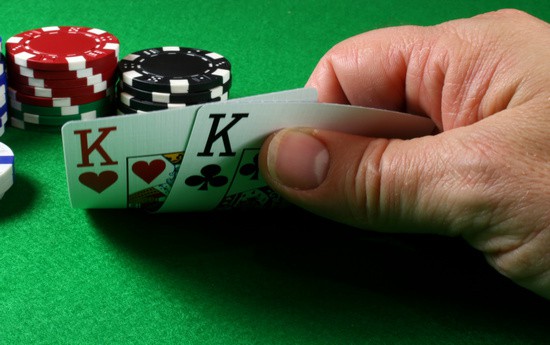Essential No Limit Holdem Strategy: Push/Fold

Introduction
Welcome to Poker Copilot’s Essential Strategy series, where we take a look at tactics, techniques, and concepts you’ll need to understand if you want to become a winning poker player.
Today’s post is about push/fold strategy – an approach that is crucial to understand and apply if you want to be successful at tournament poker.
Push/fold strategy is basically an “all or nothing” pre-flop mindset that a player goes into when their chip-stack is depleted to 10 x big blinds or below.
In a tournament, if the blind levels are 75/150 and you’re sitting with a stack of $1,480, it is time to stop thinking about limping, calling, or 3-betting preflop and consider each decision as either a fold or a shove.
Don’t let this simple explanation fool you into thinking that the concepts or mathematics behind this strategy are irrational – there is a very sound logic that drives this approach and many factors that should determine which one of these two options you choose.
Let’s start by looking at the principles and benefits of this approach.
Why Adopt This strategy?

(Source: stock.adobe.com)
In this section, we’re not looking at the finer points of what choice to make. There will be many factors that drive whether we push or fold, and in many cases, there will also be a definitive mathematical justification for the right call. For now, however, we’re going to keep it simple and just look at the basic principles of this strategy.
You’re Using Your Stack Effectively
When you’re at a stage in the tournament where the blinds represent more than 10% of your stack, it makes sense that having everyone at the table fold to you is a very positive outcome.
Let’s look at this scenario.
Your stack is worth $2,900 and the blinds are 150/300. Six players left in the tournament with the top five places getting into the money (this is a scenario referred to as the bubble).
Even without there being any limpers ahead of you, getting both blinds to fold to you results in a very welcome $450 in chips!
What are the chances of the big blind folding to you if you make a bet of $750 here? Well, if the player has a stack of $4,100, he may not think twice about calling you with quite a wide range of hands and unless you have the nuts, you do not want to take the chance on a coin flip on the bubble.
However, what are the chances of him calling you if you go all-in? Will he risk 70% of his stack with A4s? That is very unlikely in this scenario.
Don’t get us wrong here, we’re not advocating shipping with absolute trash just because you think the rest of the players at the table are playing conservatively. Simply realize that if you have a hand that you’d ordinarily bet with, it’s always a better decision to shove.
You’re Getting Maximum Value

(Source: stock.adobe.com)
In some cases when you’re applying the push/fold strategy, you’re going to get called wide by players who think you’re being reckless. This is a very good position to be in. When you find yourself with KK on the button you definitely want to be called by someone who thinks you’re just trying to steal the blinds.
What you do not want to do is give your opponent the opportunity to check/fold the flop when they don’t hit with their QTs. When you’re short-stacked, you want to get paid with your premium hands and adopting an aggressive approach here helps create a very helpful image of being loose – something that makes getting called by weaker hands all then more likely.
Doubling up when you’re short-stacked is the most effective way to get yourself back into a winning position; picking up the blinds every five or six hands will only get you so far.
What to Bear in Mind
There are many resources online that offer extremely helpful, if not downright essential, push/fold charts, online calculators, and tools that offer the information you need, but it’s still important to understand the basics here.
We highly recommend you have these on hand when playing your next tournament since they offer a mathematically sound guide on the cards that you should push or fold with in various situations.
Having said that, it is essential that you understand the reasoning behind these decisions. So let’s take a look at the factors that you should be taking into consideration when deciding whether you should push or fold.
Your Cards
When it comes down to it, the rules of poker and probability still apply whether you’re playing a standard or a push/fold game.
The math behind the push/fold strategy takes your probability of winning if you get called into consideration, so it’s essential that you don’t get into the habit of thinking that you’re only trying to get your opponents to fold.
Your shove is going to get called. Regularly. And when it does, you want to be ahead more often than you’re not. This is where the push/fold charts we mentioned above comes into play.
Your Position
As a rule, the more players who folded out of the hand before you, the wider your range for pushing should become.
The reasoning behind this rule is simple. Even though you’re playing a different strategy than traditional poker, you still need to base your decisions on all the information that your opponents are giving you about the strength of their hands. And the more who players acted before you, the more information you’re getting about who you’re potentially going up against in a showdown.
This also takes into consideration the number of players who still have to act after you – the fewer there are, the stronger your hand becomes.
When there are only four players left at the final table, you’re not going to be thinking in terms of your position relative to the button anymore. Terms like “under the gun”, and “cutoff” become irrelevant in this scenario.
This is the reason certain push/fold charts don’t refer to position, but rather the number of players who still need to act after you.
Limpers Ahead of You

(Source: stock.adobe.com)
Nothing in life is simple, right?
Sadly the math behind those invaluable push/fold charts is based on you being the first to enter the pot voluntarily. That means a limper (a player who enters the pot by calling rather than raising) or two makes referencing a chart pointless.
Does that mean you’re always folding when there was a limper ahead of you? Absolutely not! But your play is going to be reliant on some good, old-fashioned observation.
Reevaluate your decision based on what you know about the limper. Do not make a marginal shove against someone who you don’t have any data on. Ideally, you’ll have a poker heads-up display (HUD) such as Poker Copilot installed to track your opponent’s preflop playing style and you’ll have some knowledge about their VPIP range.
In the absence of this data, you’ll need to have paid attention to all your opponents’ preflop play before making this decision. Don’t shove over a limp if you don’t have any type of read on your opponent.
How many times have you seen them limp into a pot before? What was their stack size? Did they fold to a continuation bet? Did they see the river? And, most importantly, what were they holding?
It is crucial that you can answer the majority of these questions before shoving with a marginal hand – a limper severely reduces the strength of your cards.
Table Dynamics
There are going to be specific scenarios where following the push/fold strategy to the letter may not be ideal and following your read of a certain player’s temperament as well as the mood at the table may be more prudent.
As you near the bubble, you might get a read on certain players getting extremely aggressive or impatient, shoving regularly in an effort to either double up or scare their opponents. If you feel like it’s a matter of time before someone is called on their wide shoves, by all means, tighten up and ride out the storm.
Making the money when you’re short-stacked should be your number one goal and if the action at the table tells you that the bubble is about to burst, a good case can be made for letting it happen without you risking it all.
Your Opponents’ Stack Sizes
It will happen frequently that you will be in push/fold mode but have more than one player at the table with significantly fewer chips than you.
In this situation, it is often again a good move to tighten up and wait for their extremely wide pushes to get called, or for the blinds to eat away at their stacks.
Playing Against the Push/Fold Strategy
So what do you do when you’re dealt a hand that you’re planning to go all-in with, but you’re beaten to it by another player? Do you call with the same range of hands that you’d push with?
This is again extremely dependent on your read of the player and paying attention throughout the session is crucial. Alternatively, use a HUD to build data on your opponent’s preflop aggression levels.
The benefit of using a tool such as Poker Copilot is that any previous tournament you faced that particular player will be factored into the statistics the HUD displays, making your “read” on him even more accurate.
If you want to take a slightly more binary approach to this conundrum, you can use Independent Chip Model (ICM) equity numbers to calculate whether or not a call is profitable.
Since equity and pot odds are calculated based on the monetary value of the pot you’re going to win (in the case of cash games) and since tournament pot sizes aren’t a 1:1 reflection of real-currency value, how do you work out what the real-world value of your chips are?
The ICM offers a solution to this question and if you are the type of player who likes to base your decisions on cold, hard data, it is critical that you understand it and how to apply it in the heat of battle. Click here to read more on this topic.
The Math

(Source: stock.adobe.com)
If you’re inclined to understand the finer points of the thinking behind the push/fold strategy, read up on John Nash and how his work in the field of game theory influenced games of chance, manipulation, and strategy.
It is because of this Nobel Prize-winning mathematician and economist’s remarkable work in this field that people were able to compile push/fold charts and also the reason they are often called “Nash equilibrium charts”.
Read more on Nash’s theorem and how you can use it to your advantage by clicking here.
Conclusion
Push/fold strategy is arguably the closest a poker player is going to get to playing the game according to a model that defines their actions for them. This may or may not appeal to your sensibilities as a poker player, but the benefit of applying this approach is undeniable.
Having said that, nothing beats having a solid read on your opponents in addition to working according to a solid statistical framework that guides your actions.
Avoid becoming too mechanical in your decision-making and continue paying close attention to every person at your table or install a HUD to ensure that your reads are solid.
Thanks for reading our guide to playing a push/fold strategy.
See you at the tables!